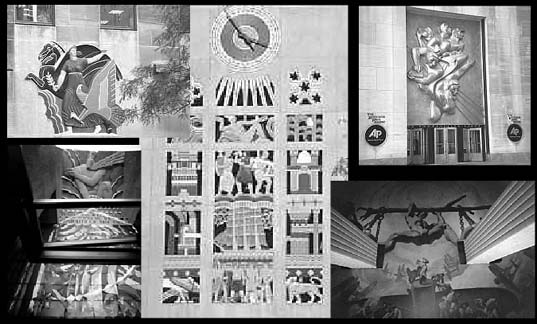|
|
| Design
Reserach Project |
Page 13
|
|
|
Public Contribution in
High-Rise Building Design
|
|
@ New York City
|
|
Rockefeller
Center : The City within the City
|
|
|
Rockefeller
- The Classical Complex
|
|
|
| The Contribution |
| II. Art Exhibition |
| As a planned modern community, an extensive
art program was essential to Rockefeller Center. In order to give the
project consistency and vitality, the theme "New Frontiers" was
chosen for the entire art program. The theme was divided into four major
phases |
| - Man's progress towards the civilization of
today |
| - Man's development in mind and spirit |
| - Man's progress along physical and scientific
lines |
| - Man's progress via industry and character
of the nation |
|
|
|
| This permits participating artists a
wide range of compatible subject material. Over 30 outstanding artists
contribute well over 100 major works for the Center's art program, now
considered one of the most interesting collections in America outside
of the museums and government buildings. |
| According to the concept, the art works
are placed in the public space. Therefore, New York pedestrians are able
to see it. These beautiful art works emphasize the value of space with
"context" that they contain. Visitors who come to Rockefeller not only
just enjoy the space, or water features but they always stop and appreciate
all the art works around the Center. There are some art works that are
related to the urban design issues of the Rockefeller Center. With that
role, those sculptures become very important icons to the center indeed.
|
|
1. Sunken Plaza - "Prometheus"
|
|
|
Executed in bronze and covered with gold leaf
by Paul Manship, this Rockefeller Center Landmark stands 18 feet high
and weights 8 tons. According to Greek mythology, Prometheus gave
man fire and the arts it controlled. The mountain-like-pedestal at
the base of the statue symbolizes the earth, while the circle containing
the signs of the zodiac represents the heavens. The red Balmoral granite
wall behind the statue bears a quotation from Aeschylus: "Prometheus,
teacher in every art, brought the fire that hath proved to mortals
a means to mighty ends."
|
Prometheus was a focal point for
the visitors who walk into the Center from Fifth Avenue via the promanade.
The Gold Sculpture was the icon that was picture taken by everybody
who come to Rockefeller Center. Every important event of the Center
was created around this sculpture. With the position, the craftsmanship
and the emphasize from the environment around it, Prometheus became
a symbol of Rockefeller itself many times. (pic: Events around Prometheus)
|
| 2. International Building - "Atlas" |
|
|
Lee Lawrie's statue of "Atlas" was cast in bronze
and weighs 14,000 pounds. The 15-foot figure rests on a 9-foot pedestal
and is more than twice life size. Each out stretched arm measures
6 feet from shoulder to fingertip.
|
In Greek Mythology, Atlas was a brother of Prometheus
and a Titan, the race of giants who warred against Zeus. After their
defeat, the Titans were either imprisoned or penalized. Atlas was
condemned to bear the world on his shoulders. In stead of the traditional
globe, Mr. Lawries's Atlas bears a huge armillary sphere with the
twelve signs of the zodiac. Its axis points to the North Star.
|
This sculpture was placed on the Fifth Ave. to
be a focal point against the strong architectural style of St. Patrick's
Church. According to the site plan of the center, the major axis was
located between the 50th and 49th Street. St. Patrick's Church was
located align to it. But to make some relations to the very important
spiritual Space of New York City, the designer did a good job to create
the minor symmetrical open space in front of International Building
and between Palazzo d' Italia and International Building North. Furthermore
they placed the Atlas which represented the strength to balance the
commercial force of the Center with the strong spiritual force from
the Church between the Fifth Ave. This open space makes way for the
people to appreciate the beauty of the Church from another side of
the street. At the same time, it also makes way for the people to
realize the elegance of the Center from the Church side.
|
The major function of the art works is to give
people who visit Rockefeller a choice to "look" at something at every
spot they sit or stand. It's not just a plaza with the water fountain.
But it contains some art works that they can appreciate. This concept
of designing can hold the people to spend more time with this public
space.
|
|
|
|
|


